|
|
||||||||||||||||||||||||
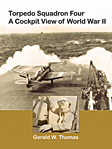 |
||||||||||||||||||||||||
|
|
||||||||||||||||||||||||
|
||||||||||||||||||||||||
|
|
||||||||||||||||||||||||
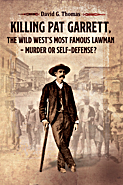 |
||||||||||||||||||||||||
 |
||||||||||||||||||||||||
 |
||||||||||||||||||||||||
|
|
||||||||||||||||||||||||
|
||||||||||||||||||||
|
USS Ranger Veterans Return to Norway |
||||||||||||||||||||
|
By Gerald W Thomas, VT-4 |
||||||||||||||||||||
|
Sandnessjøen and Fagervika In May 2001, nearly 58 years after OPERATION LEADER, a small group of USS Ranger World War II veterans returned to Norway for ceremonies honoring airmen who lost their lives during strikes on German shipping along the coast of Norway. This special visit was organized by George Pyle with the help of Steinbjørn Mentzoni and many Norwegian friends. May 16, 2001 The program planned by the Norwegians for the Ranger veterans and guests started on May 16 with a briefing on the Sandnessjøen region by a representative of the Helgelandske AS Shipping Company, followed by a luncheon. The group then visited the Home Guard facility at Sovik, where one blade of the doomed Avenger (4-T-4) is displayed. The second blade is at the Fagervika memorial and the third blade is at the Naval Air Museum in Pensacola, Florida. |
||||||||||||||||||||
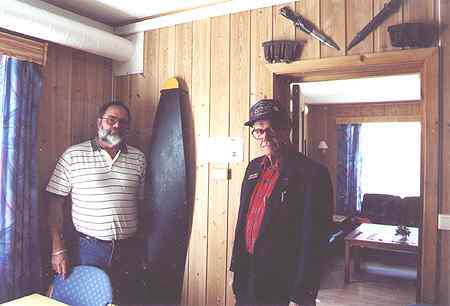 |
||||||||||||||||||||
|
T. C. Miller, nephew of Reginald (Buddy) Miller, who was killed when Avenger 4-T-4 was shot down near Fagervika, with one blade of the doomed plane. Gerald (Jerry) Thomas, on the right, was the pilot of 4-T-9 during the strike. Home Guard Headquarters, Sovik. |
||||||||||||||||||||
|
The next stop was a visit to the USSR Cemetery at Tjøtta, where over 10,000 Russian POWs are buried, many in a mass grave. A memorial ceremony was held in memory of these men. |
||||||||||||||||||||
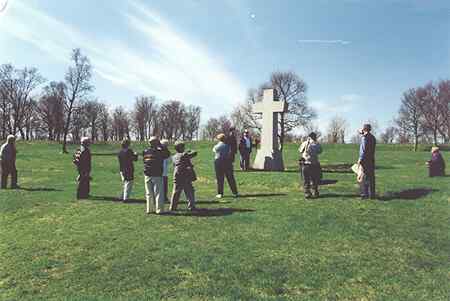 |
||||||||||||||||||||
|
USSR Cemetery at Tjøtta. |
||||||||||||||||||||
|
The last event on May 16 was an extensive and exciting tour of the beautiful fjords on the Coast Guard ship Åhav. |
||||||||||||||||||||
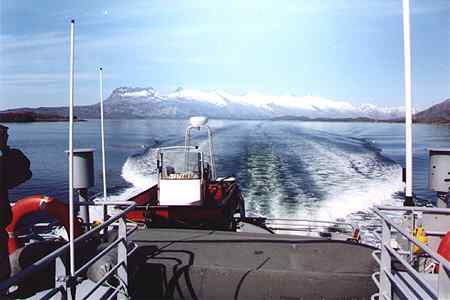 |
||||||||||||||||||||
|
Our Norwegian friends arranged for a tour of the fjords aboard the Coast Guard ship Åhav. Note the snow-capped "Seven Sisters" in the background. |
||||||||||||||||||||
|
May 17, 2001 Our group was fortunate to be present for the celebration of Norway's Constitution Day on May 17, which began with a parade in which virtually everyone in the community participated. The Norwegian Constitution dates back to May 17,1814. |
||||||||||||||||||||
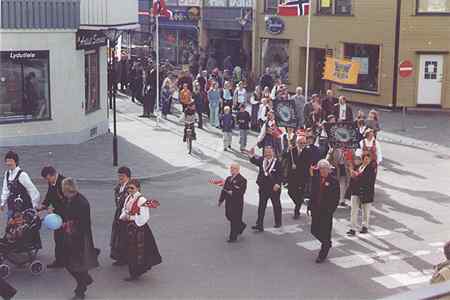 |
||||||||||||||||||||
|
Constitution Day parade. Sandnessjøen, Norway. May 17, 2001 |
||||||||||||||||||||
|
Following the parade, the group attended a luncheon hosted by the city of Sandnessjøen. A special event at this luncheon was a talk by Torvald Kibsgaard of his 3½ years as a prisoner of war of the Japanese. Torvald Kibsgaard was captured by the Japanese in Manila when Corregidor fell, survived the Bataan Death March, and was working as forced labor near Nagasaki when the atomic bomb went off. The day ended with visits to private homes in Sandnessjøen. May 18, 2001 A special event on May 18 was the dedication of a permanent plaque in honor of AMM1c Reginald H. (Buddy) Miller and ART1c Joseph L. Zalom at Fagervika. These two air crewmen were killed when the TBF Avenger (4-T-4), piloted by Lt (jg) John H. Palmer was shot down by German anti-aircraft fire on October 4, 1943. As one of the pilots on the strike, I saw Palmer's plane explode and start a gradual spiral toward the sea. Only one parachute was visible after the AA hit. The sole survivor, Palmer, was captured and taken prisoner by the Germans, eventually being moved to Stalag Luft Three. The details of this attack on German shipping is covered here. It is appropriate, however, to recognize that this special ceremony could not have been held without the efforts of Steinbjørn Mentzoni, the 9-year-old boy who saw the action and encouraged the Norwegian Navy to locate and salvage parts of the Avenger. Mentzoni and the Miller family organized the first recognition ceremony in 1987, helped with the 50th Anniversary commemoration in 1993, and worked with other Norwegians to make the 2001 visit a very memorial occasion. The Monument at Fagervika is located on a point of land overlooking where the Norwegian merchant ship Rigel was sunk on November 27, 1944. The Rigel had been taken by the Germans and was being used to transport 2,248 Russian prisoners of war and several hundred German deserters, Yugoslavs, and Norwegians being held as prisoners when it was sunk by aircraft from the HMS Implacable. Most of the prisoners and crew were lost. These men, 2571 in total, are buried at Tjøtta in a cemetery adjacent to the USSR Cemetery. The Monument commemorates these lives, as well as the lives of Miller and Zalom. The Monument contains one blade of the propeller of Avenger 4-T-4, mounted on a large stone. Below the propeller is the new plaque prepared by the Ranger veterans in honor of Miller and Zalom. |
||||||||||||||||||||
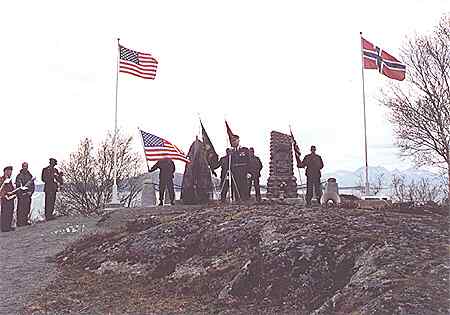 |
||||||||||||||||||||
|
Major General Hamang Age, COMAIRNON, addresses the gathering at the Fagervika Memorial on May 18, 2001. Note the American and Norwegian flags. |
||||||||||||||||||||
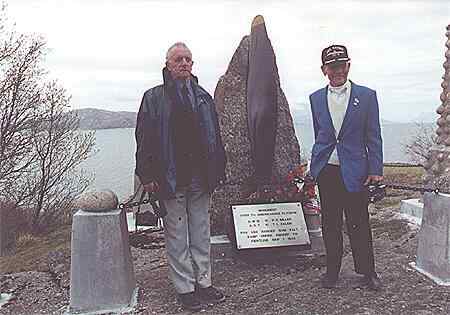 |
||||||||||||||||||||
|
Steinbjørn Mentzoni and George Pyle with the mounted propeller blade of Avenger 4-T-4. The plaque was prepared by Ranger veterans. |
||||||||||||||||||||
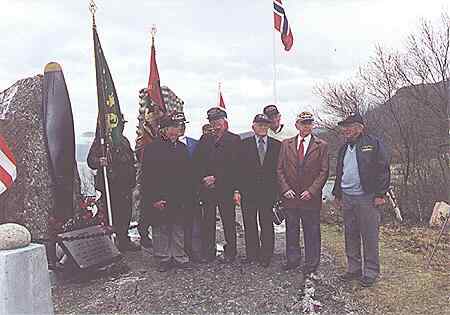 |
||||||||||||||||||||
|
USS Ranger veterans at the Fagervika Memorial, May 18, 2001. |
||||||||||||||||||||
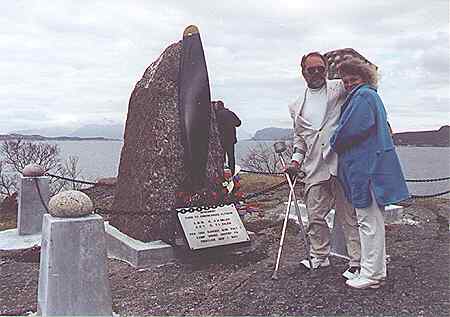 |
||||||||||||||||||||
|
T. C. Miller and Eva Miller at the Fagervika Memorial. T. C. is the nephew of Reginald Miller, who went down with Avenger 4-T-4. |
||||||||||||||||||||
|
The formal program at the Fagervika Monument began with a band playing the National Anthems of the United States and Norway. An impressive address by Major General Hamang Age, COMAIRNON, was followed with memories of OPERATION LEADER by Ranger veterans George Pyle, Joe Zeller, and Gerald (Jerry) Thomas. T. C. Miller, nephew of Reginald H. Miller, expressed thanks to the Norwegians and commented on the loss of his uncle when the plane was shot down. Following the ceremony at the Monument, the group was invited to dinner at the Helgeland Hotel in Leines with toasts to US President George W. Bush and the King of Norway, Harald V. Other toasts, comments, and good fellowship were the order of the day. General Hamang Age generously arranged a helicopter flight over the strike area for the visiting Americans. This flight brought back memories, although as one pilot faced with many distractions, I had difficulty recognizing specific landmarks. A devotional at the historic Alstahaug Church completed the day. |
||||||||||||||||||||
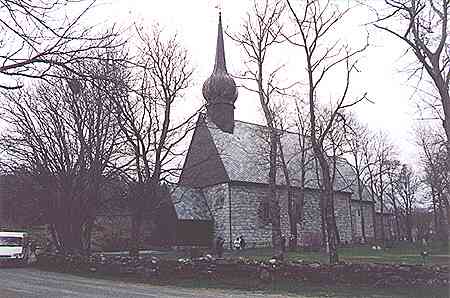 |
||||||||||||||||||||
|
The Alstahaug Church, near Sandnessjøen. |
||||||||||||||||||||
|
Bodø In addition to Sandnessjøen and Fagervika, some of the Ranger group went north to recall WWII events at Bodø. The second attack group from the Ranger, consisting of dive-bombers and fighters, had attacked German ships in Bodø harbor and vicinity. During this strike (also on October 4, 1943), Nazi anti-aircraft fire brought down two SBD Dauntless dive-bombers.
Davis and McCarley (SBD 4-B-15) Lt (jg) Sumner Davis ditched his damaged plane and he and his gunner D. W. McCarley launched a life raft. The raft was spotted by Norwegians Odd Karlsen and his father, who were fishing nearby. They took Davis and McCarley to their home. Odd Karlsen stated, "the Germans had seen the crash and had lookouts almost everywhere… there was little we could do." Germans soon located the Americans and took them prisoners of war. Davis stated that he was placed by the Germans in solitary confinement in Oslo for 10 days, then transferred to Stalag Luft One. He remained a POW for 19½ months in Stalag Luft One, losing 40 pounds while in prison. When Odd Karlsen (now 75) met Sumner Davis as he arrived at the Bodø airport in 1993 (50 years after OPERATION LEADER), they embraced, and Davis said, "You saved my life. I will never forget that." McCarley also survived German prison and he and Davis met again following the war. Tucker and Bakran (SBD 4-B-19) The second dive-bomber from Air Group 4 shot down was SBD 4-B-19. Photographs taken during the mission show the Tucker/Bakran plane over the fjords near Bodø and striking the water after being hit. There were no survivors from this crash. The special ceremony held in Bodø on October 4, 1993 (50 years after OPERATION LEADER) to honor Tucker and Bakran was well attended by both Norwegians and visiting Americans. Louise Tucker Heidelberg, wife of Lt (jg) Clyde A. Tucker, and Clyde Tucker, Jr. were honored guests. Louise was pregnant at the time Lt (jg) Tucker was shot down. Her 50 year-old son had never had the privilege of seeing his father (see Norway: A Grateful Nation Remembers). At the Norwegian Aviation Museum (Norsk Luftfartsmuseum) in Bodø, the severely damaged engine of SBD 4-B-19 is on display. This plane was located and partially salvaged by Norway several years ago. A highlight of the Bodø visit was a tour of this museum. We were escorted through this excellent facility by Major General Kjell M. Lutnes, RnoAF (retired), who is Director of the Museum. Following the tour, in a ceremony in front of the salvaged engine of SBD 4-B-19, T.C. Miller donated one of his Uncle's Navy uniforms to the museum. This uniform was one of two returned to the Miller family following the untimely death of Reginald Miller. The second uniform was donated to the Home Guard in Sandnessjøen. |
||||||||||||||||||||
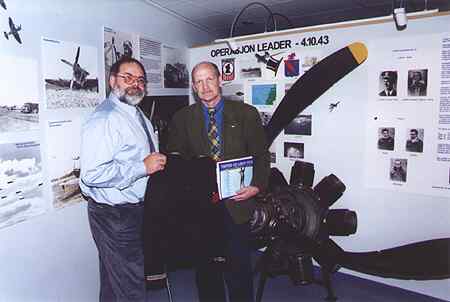 |
||||||||||||||||||||
|
T. C. Miller with Major General Kjell M. Lutnes, Director of the Naval Aviation Museum. The damaged engine salvaged from SBD 4-B-19, shot down by German AA fire on October 4, 1943, is in the background. The twisted blades show that the propeller was still spinning when the plane hit the water. General Lutnes is being presented Reginald Miller´s uniform by T. C. He holds a copy of Gerald Thomas´ book, Torpedo Squadron Four: A Cockpit View of World War II, presented to him by Thomas. May 14, 2001, Bodø, Norway. |
||||||||||||||||||||
|
A major focus of the exhibits at the Air Museum is the Cold War and NATO activities. One of the galleries contains a U-2, recalling the fact that Bodø was a landing site for the surveillance flights of the U-2 over the Soviet Union. On May 1, 1960, Francis Powers' U-2 failed to land in Bodø as scheduled. It was later learned that his plane was shot down by the Soviets. Powers managed to eject and survived, but was taken prisoner by Soviet authorities. This incident led to an even cooler relationship between the US and the Soviet Union. As part of the visit to the Air Museum, I presented a slide lecture on the history of Air Group 4 in WWII, including the tours of duty on the USS Ranger, USS Bunker Hill, and USS Essex. For a translation and analysis of the German report on OPERATION LEADER, see Operation Leader: The German View. Acknowledgments The following Americans, who participated in this historic visit to Norway to commemorate the men lost from the Ranger during OPERATION LEADER, respectfully and enthusiastically thank our many Norwegian hosts who made this an
|
||||||||||||||||||||
|
Air Group 4 - "Casablanca to Tokyo" |
||||||||||||||||||||
|
|
||||||||||||||||||||